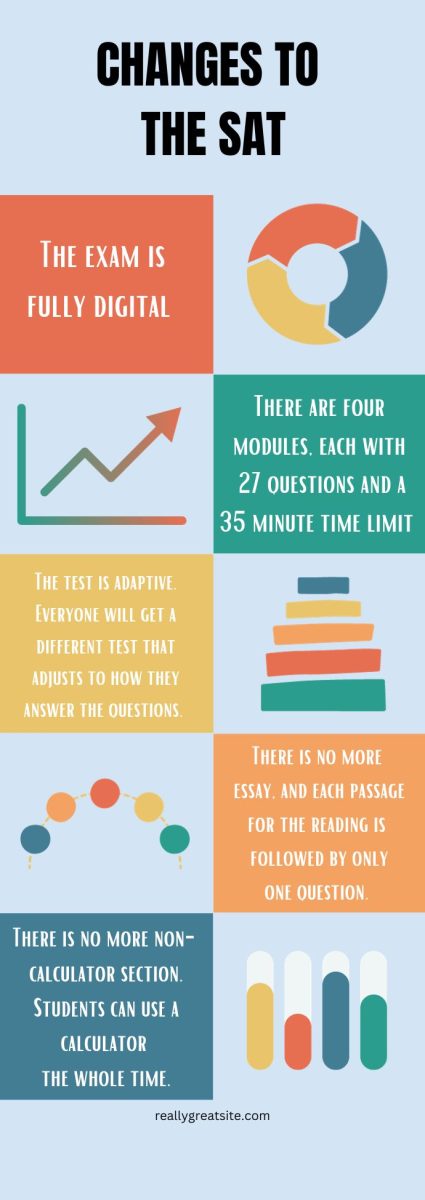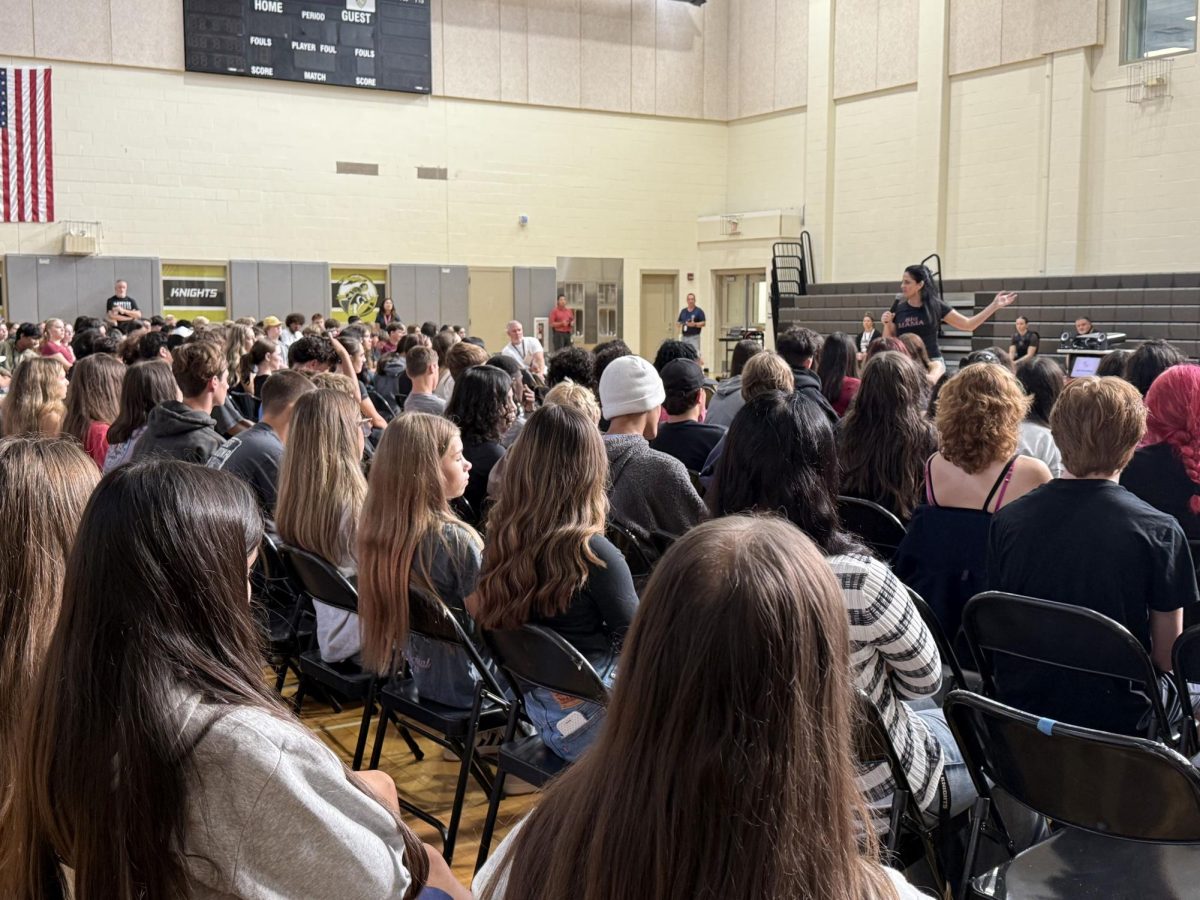The current juniors will tested the new and drastically different PSAT format that will be used again in the official SAT in April.
According to Ivy Scholars, the College Board felt the need to bring these changes for two major reasons. The first is to make the test more accessible. The test is completely digital now, so there is no worry about mail issues with the papers. With the digital aspect, there also comes a more flexible schedule and a much shorter test, just over two hours. The second major reason was to keep the SAT relevant because COVID made many schools go test-optional. The hope is that this will make schools and students remember the importance of the test.
“I think the change will be really good because so much is digital now. Yeah, that you guys are always on your Chromebooks, things like that, you understand the digital part of it,” said testing coordinator Rachel Burnette.
The SAT is split into a reading and math section, and both sections have undergone many changes. Each section is now called a module. There are two modules for both subjects. The biggest change to the math portion is that a calculator is allowed for the entire time. In past years, the first section was non-calculator and the second section allowed calculators. Calculators also had to be from the approved list made by College Board. Now the test is taken on Bluebook which will provide a calculator, or students can use demos, or just stick to an approved calculator. Both math modules are 22 questions long with 35 minutes to complete them.
“I think the math section is better for students because of the fact that you can use a calculator all the time, and so hopefully with the ability to use the calculator, it’ll save time and avoid simple mistakes,” said math teacher Jodi Sokolowski.
The reading section has also undergone a multitude of changes. Ivy Scholars says that previously there was a reading-focused section with five excerpts, each accompanied by 10-11 questions, and a writing and language section with four excerpts and 44 questions. The new test combines the reading, writing, and language questions in the same module. College Board has also gotten rid of the “no change” option in the writing section. The test has significantly shorter passages, and each is followed by a single question. The passages have gone from 500-750 words all the way down to 25-150 words. The updated test has both modules at 27 questions in 34 minutes.
“I think the reason why the test is shorter is because the questions are much more involved,” said English teacher Marcia Meyer.
The biggest overall change to the test is that because it is online, College Board is capable of making it adaptive. On paper, everyone was given the same test. Now, the first reading and the first math module will start test takers off with easy questions, then medium, and finally, hard-level questions. Once these are completed the following section’s questions will be one of two sets based on the student’s performance in the previous section. If students do well, they will be given a set of more difficult questions, and if they perform subpar, then they will get an easier set of questions. Ivy Scholars highlights that this proposes a need for a big change to how scoring works. Scoring used to be done based on the ratio of wrong to right answers, but since everyone takes a unique test, this can no longer be done. The questions are weighted by difficulty, with more difficult questions being worth more. This makes a student’s performance in the first section vital to making sure they are getting access to the harder section to get the most points.
“Well, and that’s why I think the adaptive part of it, where it won’t affect that part as much work, you know, it’s going to basically give you questions based off of how you’re answering it. It’ll zero in kind of on your level,” Sokolowski said.
It is very common in most junior English and math classes for there to be some form of prep for the SAT. With such a different test this year, teachers will be switching up how they prep students for the test, mainly including more online prep.
“I really want the kids to practice with the interface because that’s a big part of the test and very different this year. So I’m going to do both online and paper practice,” Meyer said.
While the test is drastically different this year, there are still forms in which students can prepare themselves for the test. For instance, the prep course facilitaetd by Kim Johnson and Jodi Sokolowski will still be running. The course may be slightly different from years past due to the changes, but they will still be here to support students. Normally, there are multiple practice tests given by the school second semester to get students very familiar with taking the test. This aids students in walking in on the official test date with confidence about what is expected of them. The new test makes the pool of available practice tests much smaller. The official practice SAT that takes place in January will no longer happen.
“We don’t have a way to give a digital test that we can grade on our own, so the January one, we won’t be doing. But I do believe that there still will be opportunities on the weekends through the SAT prep course,” Burnette said.
Juniors, however, don’t need to worry about preparing for the test. There are still many ways in which they can study for the test, starting with Khan Academy, which has been a very useful source of practice for many years now. The platform has a wide range of questions and provides word and video explanations to help students learn from their mistakes. Another useful platform for those who will be taking the test soon is Bluebook. This is the platform on which the digital test will now be taken. They have four full digital tests for students to take. This is one of the most useful resources students will have because the interface will be the most similar to that of the official exam.
“There are four published practice digital tests on Bluebook. We’re trying to decide where we’re going to use those tests; it’s too early to know for sure. Khan Academy is such a good resource no matter what, even if it doesn’t match the digital perfectly. It’s still got lots of good practice. I think it’s good for students to start working on it,” Sokolowski said.
There is no need to fear the changes. While different, there will still be plenty of study material. The overall consensus from teachers and staff is positive for future test-takers and in support of the changes. Scores will also be released in a matter of days rather than weeks.
“It’s going to be better for colleges, and I think it’s going to be better for students. Both sections are going to be shorter. You can go forward and backward on your questions, and your question is right there, so it’s on the screen together so you can skim. I feel like bubbling a scantron takes more time than clicking a button A or B. I think with adding the calculator, it’s going to help students,” Burnette said.








